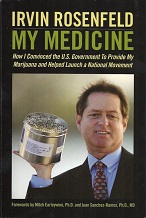
Research on mice[1] has confirmed that a “runner’s high” arises from a release of anandamide, a neurotransmitter that stimulates the same cannabinoid[2] receptors that cannabis does. If you have ever run, biked, lifted weights, or performed any kind of physical exercise, you may have noticed a sense of euphoria[3] and the feeling you are relieved of physical pain and anxiety. They thought it came from β-endorphin[4], but now scientists have confirmed that anandamide[5] is most likely the cause.
Most sources currently attribute the cause of runner’s high to β-endorphin, a compound that your body produces to relieve pain immediately after injury. β-endorphin, and other endorphins stimulate opioid receptors as does morphine and heroin. The name endorphin means endogenous morphine, or morphine that is produced in the body. While β-endorphin does indeed stimulate opioid receptors, they do so peripherally, meaning they do not enter into the brain; they simply prevent pain signals from reaching the brain. If β-endorphin doesn’t enter the brain, then how could it produce the feelings of euphoria in the runner’s high?
Upon realizing the β-endorphin does not enter the brain, scientists jumped on researching the next likely culprit of the runner’s high: anandamide. Anandamide is an endocannabinoid[6], meaning endogenous cannabinoid, or cannabis that is produced in the body.
Scientists performed experiments on mice and observed that they displayed fewer symptoms of anxiety and a higher tolerance to pain after running. They then took mice that were genetically engineered to lack endocannabinoid receptors and performed the same experiment. Those mice that had no possibility of getting affected by anandamide, had the similar levels of anxiety and response to pain as mice that did not do any exercise.
Special techniques exist to quantify anxiety and response to pain on mice, but the feeling of euphoria is much too subjective to be able to observe in mice, but the evidence they did find is enough to show that anandamide probably causes the runner’s high.
Photo Credit: Mango Kush by Sterling
References
- ^ Research on mice (www.pnas.org)
- ^ cannabinoid (hightimes.com)
- ^ euphoria (www.hightimes.com)
- ^ β-endorphin (www.ncbi.nlm.nih.gov)
- ^ anandamide (www.hightimes.com)
- ^ endocannabinoid (www.hightimes.com)
Latest
Coronavirus Strikes Massachusetts Cannabis Company Employees
Reassessing the Essential: Cannabis in the Time of a Pandemic
5 Reasons To Try Aspen Valley CBG Flower (30% Off)
High Times Cannabis Cups Go Virtual In Wake Of Coronavirus Pandemic
Drug Enforcement Administration Proposes Plan To Expand Cannabis Research
Ghana Legalizes Cannabis For Medicinal And Industrial Uses
The cheapest legal weed in Canada: Discover these cannabis ‘value brands’
Cannabis and coronavirus: Here’s what you need to know
cannabis designs
The Best Of
WHO Rules CBD Should Not Be a Scheduled Drug

Dr Cristina Sanchez PhD video interview on medical marijuana and cancer

Biochemist Dennis Hill interview; Cannabis oil as a cure for cancer.

The unofficial World Record holder for cannabis smoking part 1





